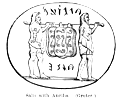Salii
(
Σαλίοι, “dancers,” from
salio). An old Italian
collegium of priests of Mars,
said to have been introduced at Rome by Numa and doubled by Tullus Hostilius. The earlier
college was called the Salii Palatīni and the later the
Salii Agonāles or Collīni. The former derived their name from their
curia
on the Palatine Hill; the latter, from the Colline Gate, near which stood their sanctuary on
the Quirinal. Both colleges consisted of twelve life-members of patrician family, and
recruited their numbers from young men, whose parents were required to be still living; at
their head was a
magister, a
praesul (leader in
the dance), and a
vates (leader in the song). The cult of the Palatine
Salii had to do with Mars, that of the Colline with Quirinus; but the chief connection of both
was with the sacred shields,
ancilia. (See illustration.) The chief
ceremonial of the Salii was in March, the beginning of the campaigning season. On March 1st,
they began a procession through the city, each of them dressed in an embroidered tunic, a
bronze breastplate, and a peaked helmet, girt about with a sword, with one of the holy shields
on the left arm, and in the right hand a staff, while trumpeters walked in front of them.
 |
|
Salii with Ancilia. (Gruter.)
|
At all the altars and temples they made a halt, and, under the conduct of the two
leaders, danced the war-dance in three measures, from which they take their name of Salii or
“dancers,” accompanying it by singing certain lays, beating their shields
meanwhile with the staves. Every day the procession came to an end at certain appointed
stations, where the shields were kept over the night in special houses, and the Salii
themselves partook of a meal proverbial for its magnificence (
Hor. Carm. i. 37, 2). Until March 24th the
ancilia were in motion; within this time some special festivities were also
held, in which the Salii took part. On March 11th there was a chariot-race in honour of Mars
(
Equiria) and a sacrificial feast in honour of the supposed fabricator of the
shields, Mamurius Veturius; on the 19th was the ceremony of the cleansing of the shields, and
on the 23d the cleansing of the holy trumpets (
tubae) of the priests,
called the
tubilustrium. The days on which the
ancilia were in motion were accounted solemn (
religiosi), and on
these days men avoided marching out to war, offering battle, and concluding a marriage. In
October, the close of the campaigning season, the
ancilia were once more
brought out, in order to be cleansed in the Campus Martius. The lays of the Salii, called
axamenta (from
axare, “to repeat,”
a word found in Festus), were referred to Numa Pompilius, and were written in the archaic
Saturnian verse, and in such primitive language, that they were scarcely intelligible even to
the priests themselves, and as early as the beginning of the first century B.C. were the
object of learned interpretation (
Quint.i. 6, 40). Two or three connected bits of these lays have come down to us. The most
intelligible is the following, reconstructed by Bergk, in a rude Saturnian measure:
|
Cumé tonás, Leucésie, |
práe tét tremónti, ||
Quom tibeí cúneí |
déxtumúm tonáront; ||
i. e.
Cum tonas, Lucetie (thou god of light),
prae te tremunt,
cum tibi cunei (bolts of lightning)
a dextra tonuerunt. (See
Wordsworth,
Fragments and Specimens of Early Latin, 564-566; Allen,
Early Latin, p. 74). Besides Mars, other deities, such as Ianus, Iupiter, and
Minerva, were invoked in them; the invocation of Mamurius Veturius formed the close (Ovid,
Fasti, iii. 260 foll.). After the time of Augustus the names of individual
emperors were also inserted in the lays.





